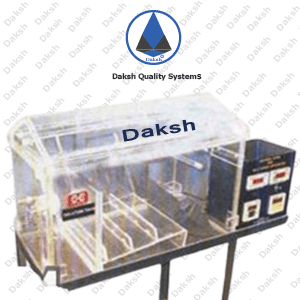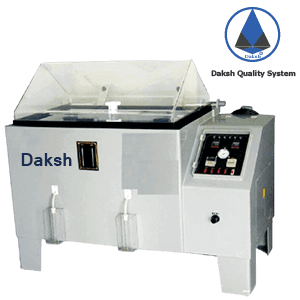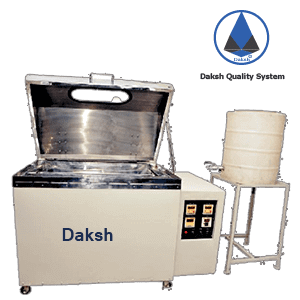
Acrylic Series
The updated models of Salt/Cass Fog Test Chamber specially designed for evaluating the corrosion resistance of the surface treatment of metallic materials by Copper Accelerated Acetic Acid Salt Spray Test Method. It consists of following parts:
DIGITAL INDICATORS CUM CONTROLLER
Its function is to indicate and maintain the temperatures. For solution tank its function is to indicate and maintain the temperatures and for test cabinet, its function is to indicate the temperature only.
DIGITAL TIMER (999 hours) WITH CUTT-OFF FACILITY
It shows the working time for the apparatus & the time consume in the process in digitally system. Time limit is for 999 hours
HUMIDITY INDICATOR WITH SENSOR
Humidity can be checked in Digitally way. Its function is to maintained during the Salt Spray with saturation of Salt Solution.
AIR REGULATOR
The Air Regulator will maintain a FRL unit Bacteria at no cost.
MIST DISPERSION AUTOMIZER
Atomizer made of S.S will be equipped in the Chamber having property of non-choking. It produces a mist of atomized solution, which is distributed uniformly throughout the exposure zone by means of Mist Dispersion Atomizer incorporated with a baffle to prevent dispersion of large liquid droplets.
FOG COLLECTION UNIT
Two Mist Cylinders are provided for measurement mist quantity. Each cylinder is with separate funnel for collection of mist.0.5 to 2.0 ml/hours.
HEATING SYSTEM
The Temperature within the Chamber maintained by Heater with Digital indicator cum controller System.
STORAGE TANK
Separate storage tank will be provided with inlet & outlet procedure for solution to the chamber with having base stand.

Salt Spray Chamber
Cyclic corrosion testing provides the best possible laboratory simulation of natu - ral corrosion. Current research indicates that cyclic corrosion testing results are similar to outdoors in resulting structure, morphology, and relative corrosion rates. Prior to cyclic testing, conventional salt spray (a continuous salt spray at 35°C) was the standard way to simulate corro - sion in a lab. Because conventional salt spray methods failed to mimic the natural wet/dry cycles of outdoors, test results frequently provided poor correlation to outdoors.
In a DAKSH cyclic corrosion tester, spec - imens are exposed to a series of different environments in a repetitive cycle that mimics outdoors. Simple cycles, such as Prohesion, may consist of cycling between salt fog and dry conditions. More sophis - ticated automotive methods may call for multi-step cycles that incorporate humid - ity, along with salt spray and dry-off. Within one DAKSH chamber, it is possible to cycle through all of the most significant corrosion environments. Even the most complex test cycles can easily be pro -
grammedwith the easy-to-operate DAKSH controller. DAKSH chambers are available in three types. The base model performs traditional salt spray and Prohesion tests. Model FRP performs salt spray, Prohesion, and most cyclic automotive tests. Model FRP adds variable relative humidity control and an optional shower function. All DAKSH chambers are avail-able in two sizes to ful?ll a range of testing requirements.
CONTROL SYSTEM :
- Temperature controller: Control laboratory temperature, in accordance with the standard temperaturesetting.
- Saturated air barrel temperature controller: Control saturated air barreltemperature
- Timer: Adjustable 1 ~ 999 hr can be arbitrary set test time, automatic stop, end with automatic zerosetting
- Heating water tank thermostat: To protect the water heating temperature, the controller is fit laboratory temperature control this tester surrounding temperature difference too big when, must cooperate with adjustment, the setting temperature is 75 degrees in thecontrol
- Timer switch: Light become warped plate, control time controller powersupply.
MACHINE INTERNAL :
- Spray tower (or baffle type): Invisible glass shower nozzle in nozzle interior, spray by tower tube guidance, then through conical disperser (or baffle) evenly dispersed spray to the laboratoryinternal
- • Fog Collector : Nozzle have eruptive fall fog quantity to free-fall way down to 80 cm of the funnel cup inside, again by duct flow to measuring cupinside.
- • Heating water tanker: This tank adherent to the laboratory bottom, used to hold water humidifying keep laboratory temperature smooth, have added wet and heat preservationfunction.
ENVIRONMENT TEST CONDITIONS :
- Environment temperature range: 15° ~60°
- Without strong electromagnetic field around the influence, no high concentration of dust and corrosivematerials
- Without strong airflow around, when the surrounding air should be forced to flow, flow should not blows directly to thebody
- Around the machine there shall be a certain distance, convenient maintenanceoperation

Stainless Steel Series
Tester has been elegantly designed strictly as per the relevant standard to evaluate the facility of rust proofed components to withstand corrosion due to atmospheric conditions. Double Walled. (Stainless Steel 316 inside & Outside Mild Steel grade.) or made up of acrylic Perspex sheet. Stainless Steel open type lid with large viewing window facility to observe samples under testing.
The updated models of Salt/Cass Fog Test Chamber specially designed for evaluating the corrosion resistance of the surface treatment of metallic materials by Copper Accelerated Acetic Acid Salt Spray Test Method. It consists of following parts: